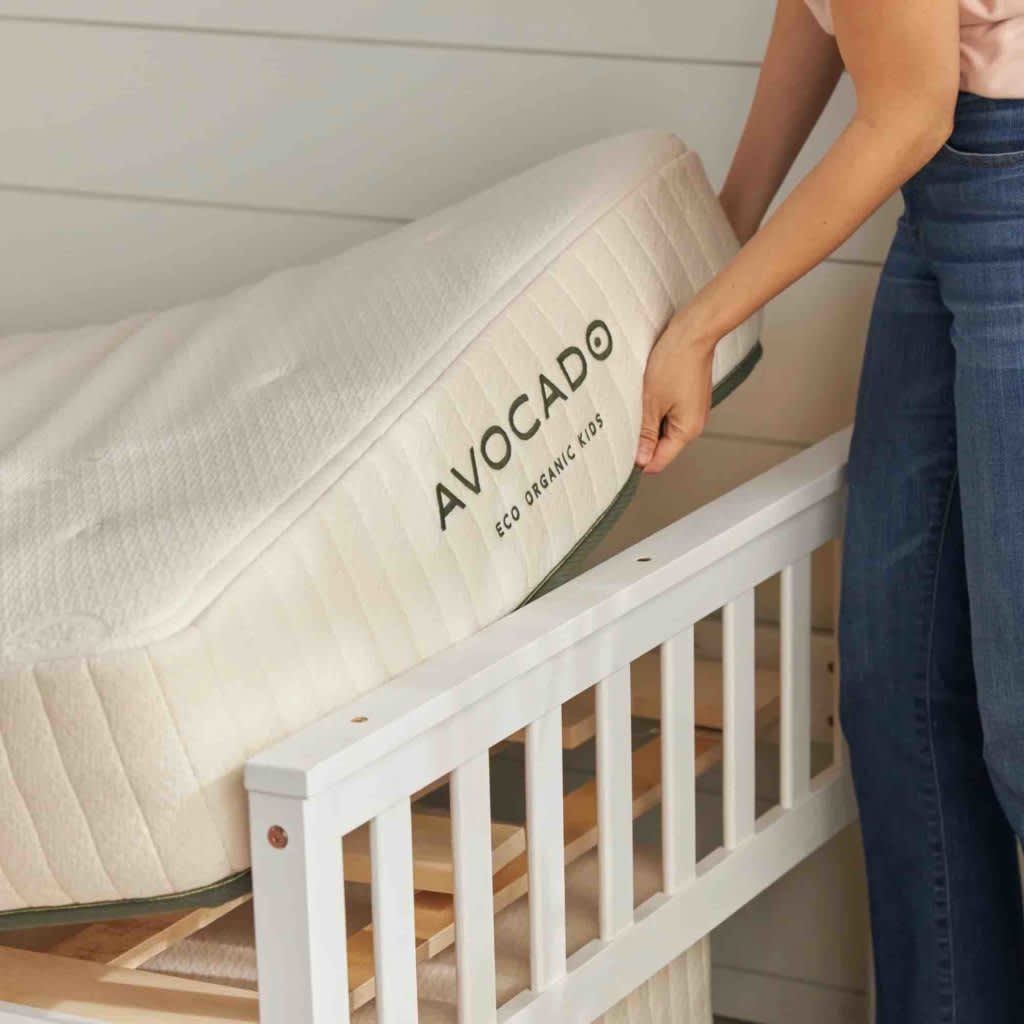On This Page
The Best Mattress for Bunk Beds
Our Top Picks
-
Best Overall Mattress
Avocado Eco Organic Kids Mattress -
Best Value Mattress
Brooklyn Bedding Kids Mattress -
Most Comfortable Mattress
Helix Kids -
Best Luxury Mattress
Nolah Nurture Kids
Best Overall Mattress

The Avocado Eco Organic Kids Mattress is a hybrid model made with high-quality materials like organic latex, wool, and cotton. The low profile, firm support, and responsive surface make this an excellent choice for kid’s bunk beds.
Pros & Cons
Pros
- Latex and coils balance pressure relief and support
- Wool and cotton promote breathability
- GOLS and GOTS organic certification
Cons
- Latex produces some motion transfer
- May be too firm for kids who enjoy feeling “hugged” by their bed
Our Take
Best Value Mattress

The BB Kids is well-made, relatively affordable, and compatible with the vast majority of bunk beds on the market today. You can choose from three child-friendly sizes, and the thin 6-inch profile ensures the utmost safety for little ones who sleep on the top bunk.
Pros & Cons
Pros
- All-foam design has a gentle surface and sturdy base
- Cover is engineered to resist stains and liquid damage
- Available in three sizes
Cons
- Strong off-gassing smells for the first few nights
- Some kids may find the mattress too firm
Our Take
Most Comfortable Mattress

The Helix Kids Mattress is a dual-sided model that offers a different firmness level on each side. Having two firmness options in one bed ensures the mattress will stay comfortable for your child throughout their growth.
Pros & Cons
Pros
- Dual-sided design offers two firmness options
- Water-repellent surface
- Breathable Tencel cover
Cons
- May not be suitable for children over age 12
- Children may notice temporary VOC odor
Our Take
Best Luxury Mattress

The Nolah Nurture 10 is a flippable hybrid mattress made with latex, wool, and organic cotton. We recommend this model for parents who prioritize beds made with non-toxic, premium materials.
Pros & Cons
Pros
- Flippable with soft and firm sides
- Made with natural materials
- Zoned support core
Cons
- Above-average price-point
- Children who enjoy feeling “hugged” by mattress may find this too bouncy
Our Take
What Is the Best Mattress Size for Bunk Beds?
The best mattress size for bunk beds depends on the size of the frame. Most bunk bed frames hold twin or twin XL mattresses. These sizes are most popular for kids and teens, but they can also accommodate solo adult sleepers.
Bunk beds designed for larger mattresses are also available. You may be interested in larger bunk beds if you’re looking to accommodate multiple adults, potentially including couples. For instance, larger bunk beds may be good to use in guest rooms. Twin-over-full or full-over-full bunk beds are fairly common options. While you can find larger sizes, such as king-over-king, these are not widely available.
Types of Bunk Beds
There are several types of bunk bed frames, each with different characteristics. Not all options take the same size mattress on each bunk, and some frames have three bunks while others have just one.
| Bunk Bed Type | What It Is | What Sizes Fit |
|
Standard |
Two mattresses of the same size, one placed above the other |
Usually twin |
|
Loft |
A bed above and an empty space below to accommodate a dresser, desk, etc. |
Twin, twin XL, or full |
|
Triple |
Three beds stacked directly above each other |
Usually twin |
|
L-shaped |
A bottom and a top bunk that are at right angles to one another, one atop the other |
Twin, twin XL, or full on top, and twin, twin XL, full, queen, or king on bottom |
|
Twin Over Full |
A twin mattress directly above a full |
Twin on top, full on bottom |
|
Trundle |
A bed that can be pulled out from under another bed frame |
Usually twin |
How to Shop for a Mattress for Bunk Beds
Shopping for any mattress requires careful consideration, but picking the right bunk bed mattress introduces unique concerns. We’ll break down what factors to consider.
Mattress Type and Durability
While each mattress model is unique, mattress type, materials, and construction impact performance and durability. Most mattresses last from 6 to 8 years, but their lifespan partially depends on how often you use the bunk bed and how you care for the mattresses. Bunk bed mattresses come in all the common mattress construction types, each of which carries unique implications for performance.
| Mattress Type | Pros | Cons |
| Foam |
|
|
| Hybrid |
|
|
| Innerspring |
|
|
| Latex |
|
|
Thickness
The recommended thickness for bunk bed mattresses varies depending on your frame. Most bunk bed frames require low-profile mattress models in order to meet Consumer Product Safety Commission standards. Bunk bed mattresses tend to be between 5 and 8 inches thick, but always refer to the documentation from your bed frame manufacturer to ensure you select compatible mattresses.
Weight Capacity
For safety reasons, bunk bed frames typically have specified weight limits. Before purchasing mattresses for bunk beds, consider the combined weights of the sleepers and their potential mattresses to ensure the total does not surpass the frame’s capacity.
Safety
Safety is of utmost importance when selecting a mattress for bunk beds. The Consumer Product Safety Commission requires that upper bunks have guardrails, and you should make sure that the top of the guardrail is at least 5 inches higher than the top of the sleep surface to reduce the risk of the sleeper rolling off. For this reason, mattress thickness or profile is a top criterion to consider before making your purchase.
Pricing
The average twin size mattress costs around $600 to $800. Size, materials, construction, and quality affect the overall cost. Keep in mind that most bunk beds use two mattresses, thereby increasing the expense.
Sleep Trial and Warranty
A sleep trial allows you to try a mattress at home and return it if it’s not a good match, while a warranty provides recourse if your mattress is defective. Both types of policies often require that the mattress be clean and free from stains or physical damage, so you might consider using a mattress protector, especially if an accident-prone child sleeps on the surface.
Video: How to Choose the Best Mattress for You
Watch our video to learn more about what all you should consider when shopping for a new mattress.
Discover More Mattress Solutions
Take a look at our other buying guides to explore more options.
More Mattress Guides
How We Test
Our in-house testing team uses a refined methodology and years of sleep product expertise to carefully assess mattress models. Testers of different body types and position preferences tried dozens of mattresses that might be appropriate for bunk beds to get a thorough overview of how they might perform for different sleepers. To select our top picks, we paid particular attention to the traits that traditionally matter most for children and teens sleeping on bunk beds, such as edge support, noise, and motion isolation.
Frequently Asked Questions
The best mattress for bunk beds combines safety, comfort, and convenience. From a safety perspective, the mattress should have a low enough profile for the upper bunk’s guardrail to be at least 5 inches higher than the sleep surface. The weight should also be low enough that the combined weight of the mattress and sleeper does not surpass your frame’s capacity.
Quietness, edge support, and breathability frequently top the list of comfort concerns, though it’s also critical to select the right firmness for the sleeper. Meanwhile, affordability, versatility, and durability impact the convenience and value.
A bunk bed mattress should be within the thickness range specified by the frame’s manufacturer. For safety reasons, the mattress surface needs to sit at least 5 inches below the top of the upper bunk guardrail, so the ideal mattress profile depends on the height of that guardrail. Most bunk bed mattresses are 5 to 8 inches thick to fit safety criteria.
The lower bunk has a bit more flexibility with regard to mattress thickness, though you’ll still want to look for a model that leaves enough headspace for the sleeper to sit up comfortably in bed.
No, not all mattresses will fit on a bunk bed. Bunk bed frames are designed to support specific mattress sizes and profiles. Refer to the bunk bed manufacturer’s specifications to determine what mattresses might work on your frame.
That said, you can find bunk bed frames outside of the traditional twin-over-twin configuration. If you’re looking to use a larger or thicker mattress model, take that into account when purchasing your bunk bed frame.
Because bunk beds traditionally use a platform construction in which the frame includes a foundation, you do not generally need a box spring. Unless your bunk bed frame specifically suggests using a box spring, adding that additional height to the sleep surface is likely to be a safety risk. Read the manufacturer’s instructions carefully to ensure you follow the best practices for your bunk bed.
You can anticipate spending about $600 to $800 per bunk bed mattress. Taking into account that you might purchase two mattresses if you’re setting up a bunk bed from scratch, that totals around $1,200 to $1,600 for the sleep surfaces. Don’t forget to also budget for any other components you need, such as the bunk bed frame, pillows, and bedding.
